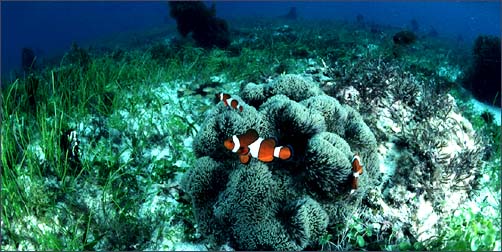
|
No. 21 Sea by the base. The Henoko Sea in Okinawa. |

|
No. 21 Sea by the base. The Henoko Sea in Okinawa. |

|
|
|
"Kakure-kumanomi", or the clown anemone fish. A clown that lives in the green grassland of the sea. Bathing in the fullness of the sun, in the blue water and green leaves, their orange color looked even more vivid. |
|
|
It was last February when I dived into the sea of Henoko in the middle part of southern Okinawa. Amidst the whirl of arguments for and against building an alternate ocean heliport for the U.S. Marines with the reversion of Futenma air base, the ocean adjacent to the camp was calm and without a ripple.
On the main island of Okinawa, when winter comes, strong seasonal winds blow out of the north and the seas that catch this wind are often rough. In contrast, the southern coast is shielded from this northerly wind and the sea is usually quiet. Without delay, I asked a local fisherman to take me to the shores off of Camp Schwab. On the shallow sea bottom that stretched out from the sandy beaches of Camp Schwab, a beautiful field of grass spread out in front of me. The seabed was covered with a family of eelgrass called the Ryukyu-sugamo. It was like a green pasture that sparkled in the sunshine that streamed in from the vicinity. The beauty took my breath away. The deep blue of the incredibly clear water and the vivid green of the seaweed created a whole different. I discovered someone who lived in this different world. It was the "kakure-kumanomi" with its bright orange, living in symbiosis with the "ibohatago" sea anemone that grows on the seabed. The English name for the "kakure-kumanomi" is the clown anemone fish. It wears its flashy clothes and lives in symbiosis with the anemone who's poison it is immune from thus the "kumanomi" fish is guarded by the poison and lives in safety. As I was watching their happy life, I became worried about the amphibious tanks which come out into the sea from Camp Schwab for training. Their life will be wiped out without a trace should the lump of iron that is the amphibious tank descend upon them. Their life is like a Russian roulette in spite of the beautiful environment that surrounds them. People do not even realize that they exist and are unaware that they do damage. The hearts and minds of humans are so distant from the sea. As I moved from the shallows into deeper waters, there were great lumps of table coral. This is the area where I spotted the "dugon". The existence¡¡of the "dugon" which has been designated as a precious natural species of Okinawa, has not even been confirmed. Ten years ago, I saw the coral reefs of Okinawa reduced to a heap of rubble by the abnormal genesis of the crown-of-thorns starfish. Upon seeing this great coral again, I wanted to exclaim in joy at the resuscitative powers of the sea. A local fisherman informed me once that this is also the area where the amphibious tanks train. In the shallow part near the edge of the coral reef, there could be seen the definite traces of the caterpillar treads. Inside the iron boxes, soldiers dedicate themselves to the training among the noise of the inorganic creaking of iron, and have little chance to see the beauty that exists outside of the box. Over the many years spent studying and observing creatures and their ecology, I have come to believe that no creature can live devoid of conflict. I do not deny the importance of a national defense and the power to resist unreasonable force but at the same time, we must understand the beauty and gentleness of the creatures that inhabit this earth with us and sometimes are sacrificed. We should also ponder the fact that our very own existence depends on their existence. Towards the end, I was shown the harvesting nearby of the Okinawa-mozuku, a type of seaweed. The farming was very simply as follows. A net on which is planted the hypha of the Okinawa-mozuku is spread upon the white coral reef on the seabed. When the "mozuku" has grown by soaking up the sunshine, the "mozuku" is gathered with a water pump. When I saw the "mozuku" in the net, it was still the early stages and the "mozuku" were short. But, they were slowly taking in the nutrients of the sea and growing under the bright sun. The "mozuku" were swaying with the waves in the leisurely rhythm of the Ryukyus. The sight brought a great peace to my heart.
|
|
|